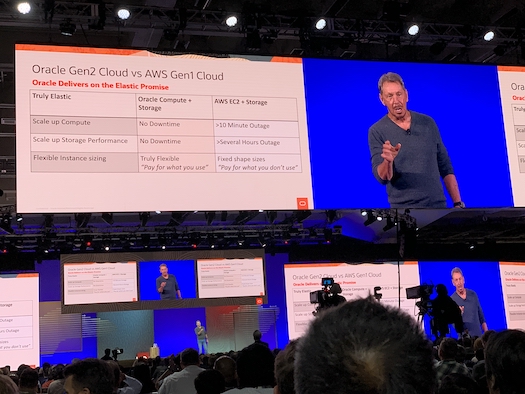Oracle made a series of individual announcements - Microsoft SQL Server availability in the Oracle cloud, a new Melbourne data centre, the release of Oracle Autonomous Linux, a free tier and more. The announcements combine to paint a bigger picture of Oracle signalling its intentions to disrupt the current cloud host leader.
Oracle founder, Larry Ellison, unveiled Oracle's autonomous cloud roadmap this week, speaking at the company's annual Oracle OpenWorld conference in San Francisco.
When you think of cloud providers a few names come to mind - AWS and Microsoft, Google, even IBM, but for those who are not Oracle database or ERP customers it's unlikely you considered Oracle in this category. Ellison, who is also the company's Executive Chairman and Chief Technical Officer, wants this to change.
Currently, if you use Oracle products you can run them traditionally, on-premise, on your own infrastructure. Or, you can run them in Oracle's cloud, where Oracle manage the infrastructure and charge a subscription fee. Or, you can have a mixture with Oracle Cloud@Customer where you provide the environment but Oracle provides the servers and software and manages it.
Previously, Oracle released the Oracle autonomous database - the world’s first and only autonomous database - where the environment itself manages its own provisioning, patching, backups, recovery, and many more functions traditionally the domain of the database administrator and systems administrator.
|
|
While Hurd himself was absent from this year’s Oracle OpenWorld for medical reasons, Ellison demonstrated clearly Oracle intends to be a major player in such a cloud-oriented future.
The major announcement this year is Oracle Autonomous Linux, fully Red Hat compatible but entirely self-maintaining with its own patching, backups, provisioning, scaling and more. If a vulnerability is found, Oracle will remediate it and the autonomous Linux will patch itself without any end-user involvement, or even a reboot.
Oracle Autonomous Linux is available now, and is available for free, in the Oracle Cloud. “If you’re paying IBM for Red Hat support,” Ellison said, “you can just stop.”
“If you want self-patching, self-healing, self-encryption you have to be prepared to pay less,” he joked.
The company provides a simple one-step conversion from Red Hat Linux to Oracle Autonomous Linux. Uptime is rated at 99.995% which assures no more than two minutes per month of downtime.
This gives Oracle Cloud a self-maintaining database and a self-maintaining operating system for other compute workloads, providing two stops on the way to a fully autonomous cloud, or the 2nd generation cloud, as Ellison calls it, to arrive in 2020.
Ellison compared Oracle’s vision to that of AWS, the current cloud host market leader. With AWS if a customer makes configuration errors and has a catastrophic data breach it is the customer’s responsibility. Ellison says this is reasonable of AWS, likening it to driving a motor car while inebriated. It’s not the car manufacturer’s fault if the operator makes a mistake. Yet, in the Oracle autonomous world, the user is simply unable to make configuration errors.
Autonomy eliminates the need for human manual involvement, which in turn eliminates human errors. So, the number one rule to prevent catastrophic data breaches is simply to take the humans out of the equation and store your data in an autonomous database, Ellison said.
It does not end here; in the AWS world systems need to be stopped to be resized, and CPU and RAM configurations are only available in specific ratios. This is not true elasticity, Ellison states. By contrast, Oracle cloud promises to allow any combination of CPU and RAM, and storage, and to be resized while running. Additionally, Oracle promises to make all its services available in every region, and for a single database product to have many possible uses vs. AWS’ multiple disparate database platforms.
Yet, what if you do not want to use Oracle, the database, for your applications? In a surprising move, Ellison announced a new relationship with Microsoft making Microsoft SQL Server now available in the Oracle cloud. This means you can run your enterprise Microsoft-based applications completely within the Oracle Cloud.
Yet, what if you want to ensure your application has the highest availability and the lowest latency? Here again, Oracle signals its intent with the announcement of new data centres coming - including Melbourne - along with another Microsoft partnership linking certain Azure data centres with Oracle. During 2020, Ellison says, Oracle will have 36 regions, more than AWS does.

The generation one cloud, like AWS, promised to be serverless and elastic, allowing organisations to pay for what they use when they use it. According to Ellison, it hasn’t achieved either. The Oracle Cloud is the “generation two cloud,” he says, which delivers serverless and elasticity, along with autonomy and security.

Oracle states it has 40,000 customers on Oracle Cloud today, including Siemens, Toyota, Kaiser Permanente, 7/11, Chipotle, Cisco, General Electric, Texas State Government, Tupperware, FireEye and others.
To get your company on-board, Ellison also announced a new Oracle free tier which provides “always free Oracle cloud for everybody.” The free tier will not expire so long as it is being used and provides two databases with one OCPU and 20GB storage each, along with all Oracle’s tools.
Additional announcements include
- new, faster Exadata X8 servers with two more cores, 28% faster clock speed, 140% more storage cores, and 40% more usable database storage
- new Exadata X8M servers with persistent memory, over 50x faster than AWS or Azure
- cluster networking
- next-generation block storage in Q4 2019
- dedicated VM hosts
- marketplace paid listings
- VMware partnership extending on-premise VMware environments to Oracle Cloud.

The writer attended Oracle OpenWorld as a guest of the company.














































